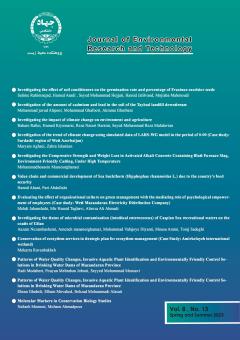-
-
-
Open Access Article
1 - Cheese whey recycling, the right approach to prevent environmental damage
Zahra Katabehei Moradi Maryam Haghighi khomami Hamed Kioumarsi hooshang dehghanzadeh saeed tamadoni jahromiToday, with increasing in production and diversity expansion of dairy products in factories and production of whey products, this food product has become very important. Whey is a water-soluble part of milk that is obtained by adding acid, heating, and coagulating the c MoreToday, with increasing in production and diversity expansion of dairy products in factories and production of whey products, this food product has become very important. Whey is a water-soluble part of milk that is obtained by adding acid, heating, and coagulating the cheese. This yellow liquid contains a lot of lactose and mineral compounds such as calcium and phosphorus, which is important to achieve in order to use as a food source and prevent environmental pollution. Since the wastewaters of the dairy industry have the highest levels of contamination, if the untreated wastewaters of this industry are discharged, serious environmental problems will be inevitable. On the other hand, a reduction in existing reserves and environmental problems followed by increasing use of fossil fuels has prompted researchers to produce new sources of renewable energy, and it can be said that new biological technologies, such as the use of whey as a way to produce biofuels, reduces the environmental problems of dischrging this kind of wastewaters into nature. Today, using biological technology, these compounds can be used to produce biofuels such as hydrogen, methane, and ethanol. So far, various methods and tests have been performed to produce these fuel sources and in this study, the effective strategies for recycling whey and preventing environmental damages are investigated. Manuscript profile -
Open Access Article
2 - Effect of Pennyroyal (Mentha Pulegium L.) on Performance, Carcass Characteristics and Some of the Blood Parameters in Broilers
Ali Reyan Mohasesi Hasan Darmani Koohi Reza Naseri Harsini Ali Mirza Aghazadeh Hamed KioumarsiTo investigate the effects of pennyroyal (Mentha pulegium L.) powder on performances, the concentration of some blood parameters and carcass characteristics of broilers, 160 one-day-old Ross chicks were used in the form of a completely randomized design with four treatm MoreTo investigate the effects of pennyroyal (Mentha pulegium L.) powder on performances, the concentration of some blood parameters and carcass characteristics of broilers, 160 one-day-old Ross chicks were used in the form of a completely randomized design with four treatments and four repetitions. Experimental treatments included the levels of zero (control), 0.2%, 0.4%, and 0.6% of pennyroyal powder. The treatment containing 0.6% of pennyroyal powder compared to the control group had higher feed consumption in the starter period (P <0.05). However, there was no significant difference during the growth period and the whole experimental period. In terms of average daily weight gain and feed conversion ratio, there was no significant difference between the experimental treatments during the starter, growth and the whole experimental periods. The carcass percentage decreased significantly at the age of 42 days in treatments containing pennyroyal powder compared to the control group (P <0.05). There was no significant difference between experimental treatments in terms of weight percentage of carcass components including thigh, chest, abdominal fat, heart, liver, and gizzard. The concentration of triglycerides and plasma VLDL decreased significantly in treatments containing pennyroyal powder and decreased linearly compared to the control group (P <0.05). In terms of cholesterol and plasma HDL levels, a significant decrease was observed in treatment containing 0.4 level and treatment containing 0.2 percent of pennyroyal powder compared to the control group (P <0.05) respectively. Plasma LDL levels were not affected by experimental treatments. The results of the present study showed that the use of limited levels of pennyroyal powder up to 0.6% has no significant effect on the performance of broilers. Manuscript profile
List of Articles Hamed Kioumarsi
-
The rights to this website are owned by the Raimag Press Management System.
Copyright © 2017-2024


